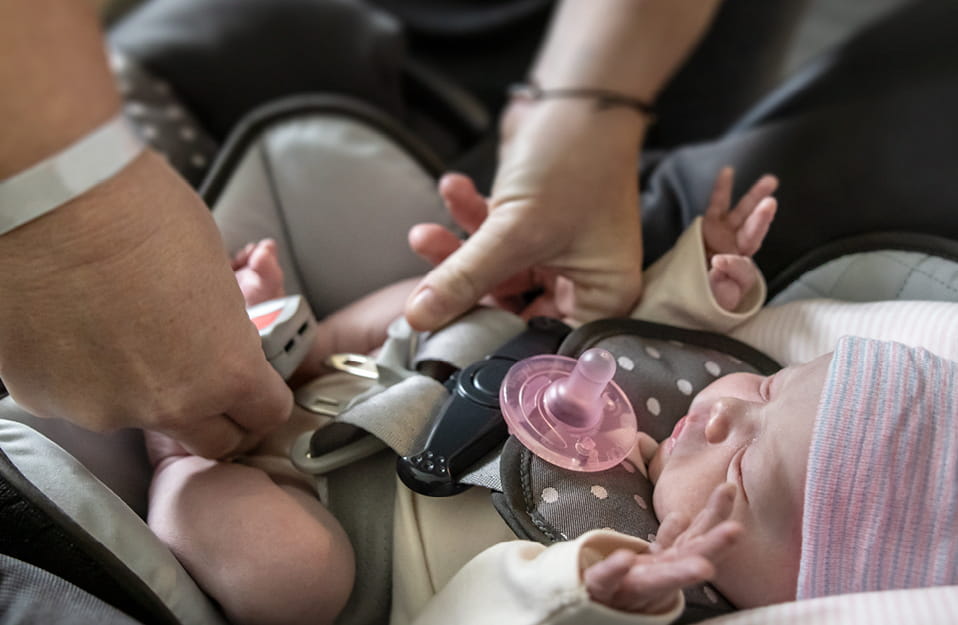What it’s like to have gestational diabetes during pregnancy
With the right treatment and support, you can handle gestational diabetes. Here’s how this mom did it.
At just 10 weeks into her pregnancy, Brianna Porreca found out she had gestational diabetes.
Pregnant women are typically evaluated for gestational diabetes between weeks 24 to 28 of pregnancy. But due to a strong family history of diabetes, Ms. Porreca was tested early.
When she first heard the news, she felt scared and ashamed. “I didn’t want anyone to know,” she says. “I had this ideal picture of my pregnancy in my mind and with no health concerns, I never thought I’d have a complication like this.”
Kathryn Boudeman, RDN, CDCES, dietitian and diabetes educator at Geisinger, explains feeling like this is normal. “Learning you have gestational diabetes can be overwhelming,” she says. “But with careful monitoring and treatment, you can have a healthy pregnancy and baby.”
What is gestational diabetes — and what causes it?
Gestational diabetes is a form of diabetes that appears only during pregnancy.
“It occurs when hormones from your placenta block insulin from working as it should, preventing your body from regulating your blood sugar levels properly,” explains Ms. Boudeman. “This causes hyperglycemia, or high blood sugar levels, which leads to the health concerns associated with gestational diabetes.”
Who’s at risk for developing gestational diabetes?
Most women have at least one risk factor for developing gestational diabetes. That’s why it’s common practice to screen all women during pregnancy.
Some of these risk factors include:
- Being overweight before and during pregnancy
- Living a sedentary (inactive) lifestyle
- Having a family history of diabetes
- Being diagnosed with gestational diabetes in a previous pregnancy
- Being of Hispanic, African American, Native American, South or East Asian or Pacific Island descent
Managing gestational diabetes with a dream team
Working as a registered nurse (RN) in a neonatal intensive care unit (NICU) earlier in her career, Ms. Porreca saw first-hand how complications with gestational diabetes can affect babies. “Because of this, I was determined to keep my baby healthy,” she says.
If gestational diabetes goes untreated, it can cause potentially serious issues for mom and baby. “This is why it’s so crucial to work with your care team right away to get your blood sugar levels in check,” explains Ms. Boudeman.
That’s where her supportive Geisinger care team comes in: Maternal-fetal medicine (high-risk pregnancy) specialist Rachel Rolison, CRNP and dietitian and diabetes educator Kathryn Boudeman, RDN.
“I also had a lot of support from my mom Susan Generose, RDN, who also happens to be a dietitian and diabetes educator at Geisinger,” Ms. Porreca added.
To treat and manage her gestational diabetes, Ms. Porreca worked with her dietitian to create a healthy meal plan. “It took some time to get everything balanced (i.e. proteins, carbs and healthy fats), but once I did, it was easy to keep my blood sugar levels stable,” she says.
Ms. Porreca was also closely monitored by her maternal-fetal medicine specialist. “I tested my blood sugar levels daily and sent the results to my provider through myGeisinger,” she says. “My anxiety faded, and I felt confident.”
Starting insulin at 31 weeks
At around 31 weeks, Ms. Porreca noticed a spike in her blood sugar levels. “Sometimes diet and exercise alone aren’t enough to manage gestational diabetes,” explains Ms. Boudeman. “To help keep blood sugars in a healthy range, your healthcare provider may recommend that you take insulin.”
Ms. Porreca started taking a small dose of a long-acting insulin at night and continued to do so for the rest of her pregnancy.
Because gestational diabetes is considered a pregnancy complication, women who have it are more likely to be induced. And that’s just what happened.
“I was seeing my maternal-fetal medicine specialist for growth scans every 4 weeks to monitor my baby’s growth,” she says. “It was then recommended that I be induced at 39 weeks.”
A safe and healthy delivery
With her induction date set for December 9, 2020, she and her husband packed their bags and headed to Geisinger Medical Center in Danville. After 43 hours of labor, their son was born on Dec. 11, weighing in at 7 pounds, 8 ounces — and no complications for baby or mom.
“We made it through the first 12 hours without any low blood sugars, which is a common complication for infants of moms who had gestational diabetes,” she says.
Today, mom and baby are happy and thriving. “He is so worth every hardship,” she says. “I wouldn’t trade any of this experience for the world.”
Next steps:
Here's what to pack in your hospital delivery bag
Postpartum depression: let's talk about it.
Learn about pregnancy care at Geisinger





